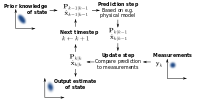
Photo from wikipedia
This note presents new results on the design of the process noise covariance matrix in Kalman filtering. The proposed design belongs to the realm of worst case methods: the optimal… Click to show full abstract
This note presents new results on the design of the process noise covariance matrix in Kalman filtering. The proposed design belongs to the realm of worst case methods: the optimal covariance is sought such as to maximize an upper bound on the estimation error matrix under a total budget constraint. Optimality conditions are derived along with a numerical algorithm for iterative approximation of the optimal solution. The optimal solution features a few time points and the associated covariances. Broadly speaking, the process noise is only “active” at the time points that enhance its controllability. The importance of the method is that it bounds from above the performance of any Kalman filter with a different design. Monte Carlo simulations on a double harmonic system numerical example illustrate the good convergence, performance, and low sensitivity to initial guesses of the proposed method. Moreover, in terms of estimation accuracy, the Kalman filter with the optimal design outperforms a robust $H_2$ filter designed to cope with an equivalent uncertainty.
Journal Title: IEEE Transactions on Automatic Control
Year Published: 2019
Link to full text (if available)
Share on Social Media: Sign Up to like & get
recommendations!